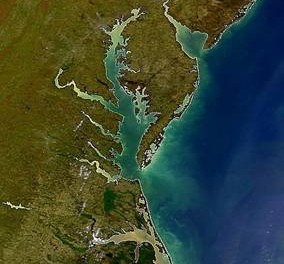Clean Air Act & Cleaning Up Chesapeake Bay
The Local Fight to Save the Chesapeake Becomes a National Fight Over the Clean Water Act
Read full article at:
The fight to restore the largest estuary in the US — the Chesapeake Bay — has attracted national attention, and considerable special interest money, as states, cities and trade groups weigh in on the extent of the Environmental Protection Agency’s authority to protect our waters.
The communities around the Chesapeake Bay, renowned for its wildlife, have been struggling for years to restore the area’s ecosystem and reverse the decline in the marine life for which the region is known. Pollution from farming, industry and housing developments has lead to dead zones in areas where oxygen levels in the water are too low to support life. Over the past two and a half decades, states repeatedly missed their own deadlines for reducing their pollution.
In 2000, the Republican-led US Congress mandated, under the Clean Water Act, that states near the Bay improve the waters by 2010 so it could be removed from the EPA’s impaired waters list. But in 2007, the Chesapeake Executive Council, made up of officials from Maryland, Pennsylvania, Virginia and DC, announced that the states would not be able to meet the water quality goals they had set.
So, in 2009, the Obama administration stepped in with an executive order, requiring the EPA to use a provision of the Clean Water Act to put together the Chesapeake Clean Water Blueprint. The Blueprint would set a “Total Maximum Daily Load,” or TMDL, an upper limit for the amount of nitrogen, phosphorus and sediment pollution that can enter the Bay each day. The plan reduced nitrogen and phosphorus loads by about 25 percent and sediment loads by 15 percent from 2009 levels (though the exact goals vary by state).
The six states in the Chesapeake Bay watershed — Delaware, Maryland, New York, Pennsylvania, Virginia and West Virginia — as well as Washington, DC, submitted proposals to meet those TMDL deadlines by 2025. If they missed those deadlines, the EPA would take action against them. For the first time, regulators had an enforceable plan for reducing pollution in the Bay.
But then monied interests made their voices heard.
Groups including the American Farm Bureau Federation, the National Association of Home Builders, the National Corn Growers Association, the National Pork Producers Council, the Pennsylvania Farm Bureau, the Fertilizer Institute and the US Poultry & Egg Association have been fighting the EPA’s plan in court. After a Pennsylvania federal judge ruled in favor of the EPA last September, the groups filed an appeal.
And that appeal became grounds for the issue to go national.
Twenty-one state attorneys general, representing states as far away as Texas, Wyoming and Alaska, waded into the fight. The attorneys general filed an amicus brief in the appeals process, even though only one of the states, West Virginia, had been involved in the Chesapeake Bay cleanup. The Washington Post’s Darryl Fears notes that even though the attorneys general described their brief as a bipartisan effort, the states they represented were almost unanimous in voting against Obama in 2012.
The attorneys general wrote that they were afraid the government would take similar action in their own states. “If this TMDL is left to stand, other watersheds, including the Mississippi River Basin (which spans 31 states from Canada to the Gulf Coast), could be next,” they wrote. (The Mississippi River Basin is also heavily polluted with nitrogen and phosphorus from the large midwestern farms that line its northern banks. Researchers found that between 2000 and 2010, nitrite levels rose 12 percent where the Mississippi River meets the Gulf of Mexico.)
“To say we are outraged is a vast understatement,” Will Baker, president of the Chesapeake Bay Foundation, a major force behind the cleanup, told Miami Herald columnist Carl Hiaasen. “We find it almost beyond belief for any state outside of the Chesapeake Bay watershed to try to sue to stop us from cleaning up our waters. What are they afraid of if we have clean water in the Chesapeake Bay?”
The forces opposing the Bay cleanup are political heavy-hitters. The top three spenders — the American Farm Bureau, Fertilizer Institute and the National Association of Home Builders — gave over $4 million to national-level politicians and spent over $18.5 million on lobbying during the 2011-2012 election cycle, according to FEC filings. That same year, the Farm Bureau and its state member organizations devoted a significant portion of their lobbying power to weigh in on a Republican-sponsored bill to “support efforts to reduce pollution of the Chesapeake Bay watershed.” The bill never made it out of committee. In this election year, both state and national politicians will no doubt be hoping for more contributions from groups like these.
….click here to read the rest of the article.
http://billmoyers.com/2014/04/23/the-local-fight-to-save-the-chesapeake-becomes-a-national-fight-over-the-clean-water-act/
Author of the article




Leave a comment